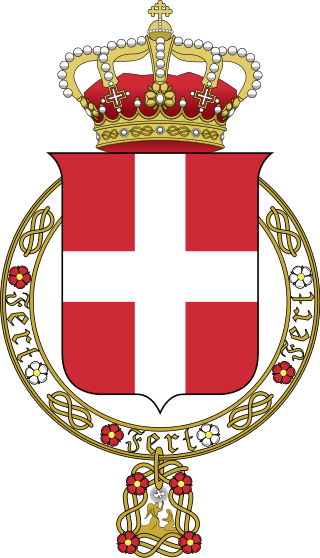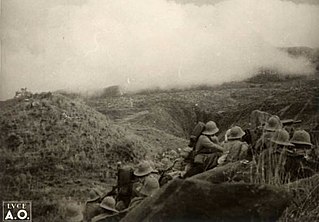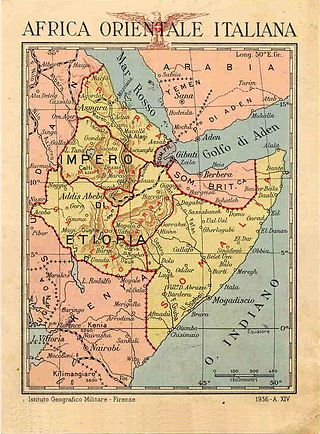
Italian East Africa was an Italian colony in the Horn of Africa. It was formed in 1936 after the Second Italo-Ethiopian War through the merger of Italian Somaliland, Italian Eritrea, and the newly occupied Ethiopian Empire.

Victor Emmanuel III, born Vittorio Emanuele Ferdinando Maria Gennaro di Savoia, was King of Italy from 29 July 1900 until his abdication on 9 May 1946. A member of the House of Savoy, he also reigned as Emperor of Ethiopia (1936–41) and King of the Albanians (1939–43) following the Italian invasions of Ethiopia and Albania. During his reign of nearly 46 years, which began after the assassination of his father Umberto I, the Kingdom of Italy became involved in two world wars. His reign also encompassed the birth, rise, and fall of the Fascist regime in Italy.

The House of Savoy is an Italian royal house that was established in 1003 in the historical Savoy region. Through gradual expansions the family grew in power, first ruling a small Alpine county northwest of Italy and later gaining absolute rule of the Kingdom of Sicily. During the years 1713 to 1720, they were handed the island of Sardinia and would exercise direct rule from then onward.

Umberto II was the last King of Italy. Umberto's reign lasted for 34 days, from 9 May 1946 until his formal deposition on 12 June 1946, although he had been the de facto head of state since 1944. Due to his short reign, he was nicknamed the May King.

Pietro Badoglio, 1st Duke of Addis Abeba, 1st Marquess of Sabotino, was an Italian general during both World Wars and the first viceroy of Italian East Africa. With the fall of the Fascist regime in Italy, he became Prime Minister of Italy.

Duce is an Italian title, derived from the Latin word dux, 'leader', and a cognate of duke. National Fascist Party leader Benito Mussolini was identified by Fascists as Il Duce of the movement since the birth of the Fasci Italiani di Combattimento in 1919. In 1925 it became a reference to the dictatorial position of Sua Eccellenza Benito Mussolini, Capo del Governo, Duce del Fascismo e Fondatore dell'Impero. Mussolini held this title together with that of President of the Council of Ministers: this was the constitutional position which entitled him to rule Italy on behalf of the King of Italy. Founder of the Empire was added for the exclusive use by Mussolini in recognition of his founding of an official legal entity of the Italian Empire on behalf of the King in 1936 following Italy's victory in the Second Italo-Ethiopian War. The position was held by Mussolini until 1943, when he was removed from office by the King and the position of Duce was discontinued, while Marshal The 1st Duke of Addis Abeba was appointed Presidente del Consiglio.
The following is a timeline relating to the Second Italo–Ethiopian War to the end of 1936. A number of related political and military events followed until 1942, but these have been omitted.

Princess Phương Mai of Vietnam, Duchess of Addis Abeba was a daughter of Emperor Bảo Đại of Vietnam and his first wife, Empress Nam Phương. In 1947, Nam Phương left Vietnam with her children and lived at the Château Thorens, outside of Cannes, France. Phương Mai received her education in France and returned to Vietnam from 1949 to 1953. She was educated at Convent des Oiseaux in Verneuil sur Seine, France.

The Italian nobility comprised individuals and their families of the Italian Peninsula, and the islands linked with it, recognized by the sovereigns of the Italian city-states since the Middle Ages, and by the kings of Italy after the unification of the region into a single state, the Kingdom of Italy.

Prince Amedeo, 3rd Duke of Aosta was the third Duke of Aosta and a first cousin once removed of the King of Italy, Victor Emmanuel III. During World War II, he was the Italian Viceroy of Italian East Africa.

The second battle of Tembien was fought on the northern front of the Second Italo-Ethiopian War. This battle consisted of attacks by Italian forces under Marshal Pietro Badoglio on Ethiopian forces under Ras Kassa Haile Darge and Ras Seyoum Mangasha. This battle, which resulted in a decisive defeat of Ethiopian forces, was primarily fought in the area around the Tembien Province. The battle is notable for the large-scale use of mustard gas by the Italians.
The first battle of Tembien was fought on the northern front of what was known as the Second Italo-Ethiopian War. This battle consisted of attacks and counterattacks by Italian forces under Marshal Pietro Badoglio and Ethiopian forces under Ras Kassa Haile Darge. This battle was primarily fought around Worsege Pass in what was then the Tembien Province of Ethiopia.

The Battle of Amba Aradam was fought on the northern front of what was known as the Second Italo-Abyssinian War. This battle consisted of attacks and counter-attacks by Italian forces under Marshal of Italy Pietro Badoglio and Ethiopian forces under Ras Mulugeta Yeggazu. This battle was primarily fought in the area around Amba Aradam which included most of Enderta Province.

The Battle of Shire was fought on the northern front of what was known as the Second Italo-Abyssinian War. This battle consisted of attacks and counterattacks by Italian forces under Marshal of Italy Pietro Badoglio and Ethiopian forces under Ras Imru Haile Selassie. This battle was primarily fought in the Shire area of Ethiopia.

The March of the Iron Will was an Italian offensive occurring from 26 April to 5 May 1936, during the final days of the Second Italo-Ethiopian War. Its goal was to capture the Ethiopian capital, Addis Ababa, in a show of force for Fascist propaganda. An Italian mechanized column under the command of Pietro Badoglio, Marshal of Italy, advanced from the town of Dessie to take Addis Ababa. The march covered a distance of approximately 200 miles (320 km).

Eritrea Governorate was one of the six governorates of Italian East Africa. Its capital was Asmara. It was formed from the previously separate colony of Italian Eritrea, which was enlarged with parts of the conquered Ethiopian Empire following the Second Italo-Ethiopian War.

Italians of Ethiopia are Ethiopian-born citizens who are fully or partially of Italian descent, whose ancestors were Italians who emigrated to Ethiopia starting in the 19th century during the Italian diaspora, or Italian-born people in Ethiopia.

Italian Ethiopia, also known as the Italian Empire of Ethiopia, was the territory of the Ethiopian Empire, which Italy occupied for approximately five years. Italian Ethiopia was not an administrative entity, but the formal name of the former territory of the Ethiopian Empire, which now constituted the Governorates of Amhara, Harar, Galla-Sidamo, and Scioa after the establishment of Italian East Africa.

Pietro d'Acquarone, I Duke d'Acquarone was an Italian aristocrat, Brigade General, entrepreneur and politician. He was nominated to the Senate of the Kingdom of Italy in 1934. Close to the royal family, in 1939 he was appointed Minister to the Royal Household. He was a trusted advisor to the King during the difficult later years of the Mussolini régime, and played a central role in the final meeting of the Grand Council that took place overnight on 24/25 July 1943, and in the frantic consultations that ensued. He accompanied Victor Emmanuel III to Pescara and Brindisi on 9/10 September 1943 and then stayed with the King until the latter's abdication 32 months later.

The Count of Verampio is a title in the Peerage of Italy. The last remaining heirs related to the title are the Castellini Baldissera family.















